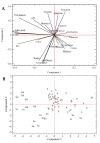Botanical Origin, Pollen Profile, and Physicochemical Properties of Algerian Honey from Different Bioclimatic Areas
- PMID: 32708524
- PMCID: PMC7404483
- DOI: 10.3390/foods9070938
Botanical Origin, Pollen Profile, and Physicochemical Properties of Algerian Honey from Different Bioclimatic Areas
Abstract
The palynological and physicochemical analysis of 62 honey samples produced in different biogeographical areas of Algeria was conducted. Results showed high variety in the botanical origin of samples and their physicochemical profile. Twenty-six samples were polyfloral honey, 30 were unifloral honey from different botanical sources such as Eucalyptus, Citrus, Apiaceae, Punica, Erica, Rosmarinus, Eriobotrya, or Hedysarum, and 6 were characterized as honeydew honey. Pollen analysis allowed the identification of 104 pollen types belonging to 51 botanical families, whereas the physicochemical profile showed important variations between samples. Multivariate techniques were used to compare the characteristics of samples from different biogeographical areas, showing significant differences between humid-area samples, located in the northeast of the country, and samples taken in semiarid, subhumid, and arid zones. Principal-component analysis (PCA) extracted nine components explaining 72% of data variance, being 30%, the sum of Component 1 and Component 2. The plot of both components showed samples grouped upon botanical and geographical origin. The results of this paper highlighted the great variability in honey production of Algeria, evidencing the importance of honey characterization to guarantee authenticity and to valorize local production.
Keywords: Algerian honey; biogeographical origin; botanical origin; characterization.
Conflict of interest statement
The authors declare no conflict of interest
Figures



References
-
- Hussein M.H. A review of beekeeping in Arab countries. Bee World. 2000;81:56–71. doi: 10.1080/0005772X.2000.11099473. - DOI
-
- Makhloufi C., Kerkvliet J.D., D’albore G.R., Choukri A., Samar R. Characterization of Algerian honeys by palynological and physico-chemical methods. Apidologie. 2010;41:509–521. doi: 10.1051/apido/2010002. - DOI
-
- Migliore J. Plant biogeography in the western mediterranean basin: New insights from phylogeographical studies. BMIB-Bollettino dei Musei e degli Istituti Biologici. 2013;75:64–68.
-
- Médail F., Quézel P. Hot-Spots Analysis for Conservation of Plant Biodiversity in the Mediterranean Basin. Ann. Mo. Bot. Gard. 1997;84:112–127. doi: 10.2307/2399957. - DOI
LinkOut - more resources
Full Text Sources

